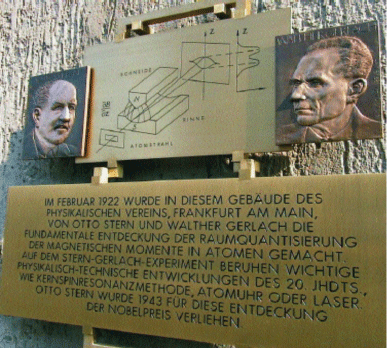In the subatomic world governed by quantum mechanics, nuclei are better thought of as fuzzy "probability waves" rather than solid "objects". Because of the Heisenberg Uncertainty Principle, we cannot know the exact direction of a particle's spin at any point in time. However, we can measure and know with certainty some limited properties about the spin, such as a component of its angular momentum along a single direction. Such a physically measurable quantity is known as an eigenvalue corresponding to a particle's pure spin state or eigenstate. (In German, the word "eigen" means "own" or "self").
The number of eigenstates (or pure spin states) for a nucleus with spin = I is given by:
Hence for the ¹H nucleus with I = ½, there are 2(½) + 1 = 2 possible spin states. Note that nuclei with higher values of I may have more than a dozen spin states, but for now we will just consider the two spin states of ¹H. These states are commonly denoted as ∣ +½ 〉and ∣ -½ 〉often referred to as "spin-up or "parallel" and spin-down or "anti-parallel" respectively. The implications of these alternate terms will become apparent shortly.
Otto Stern and Walther Gerlach performed a famous experiment demonstrating this phenomenon in 1922. Spin-½ silver atoms were boiled off from an oven, passed between the poles of a strong magnet, and then allowed to deposit on a glass plate. Instead of a single smear of silver corresponding to all possible spin orientations, exactly two silver spots were detected. The atoms had apparently sorted themselves into "spin up" and "spin down" states as they passed through the field. This is perhaps the most tangible proof of the quantization of angular momentum that can be made to appear in the macroscopic world.
Advanced Discussion (show/hide)»
We now know Stern and Gerlach were actually detecting the two spin states of an outer shell electron rather the silver nucleus. Nevertheless, their results are still valid and provide a memorable and tangible demonstration of the spatial quantization of angular momentum.
As a humorous side note, the two dots of the Stern-Gerlach experiment were said to have been discovered fortuitously only when the disassembled apparatus was inspected by Stern (a lover of cheap cigars). The black spots observed were silver sulfide formed by the smoke from Stern's cigar.
"Introduction to Eigenstates." Wikipedia, The Free Encyclopedia.
Cresser JD. Particle spin and the Stern-Gerlach experiment (pdf). Lecture notes in quantum mechanics, Chapter 6, from: physics.mq.edu.au/~jcresser/Phys301.html (27 April 2009)
Friedrich B. Review. A century ago the Stern-Gerlach experiment ruled unequivocally in favor of quantum mechanics. Isr J Chem 2023; 63:e202300047. (This is a scholarly historical review of the events leading up to and after the S-G experiment. It should be a “must read” for every college physics professor.) [DOI Link]
Friedrich B, Herschbach D. Stern and Gerlach: How a bad cigar helped reorient atomic physics. Physics Today 2003; 56:53-59. [DOI LINK]
Gerlach W, Stern O. Über die richtungsquantelung im magnetfeld. Ann Phys 1924;74:673-699.
What is spin?
How do you predict the value of nuclear spin (I) based on the number of protons and neutrons?
Where does the energy come from to keep the precession going?


